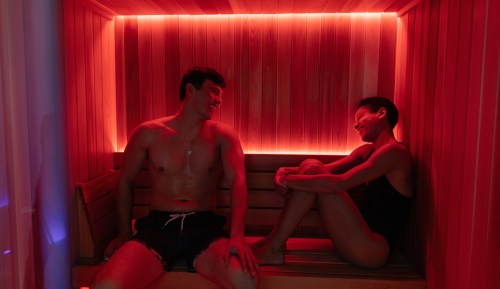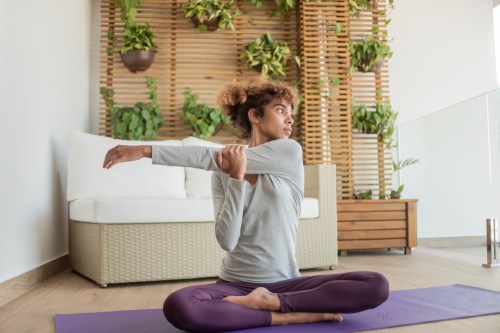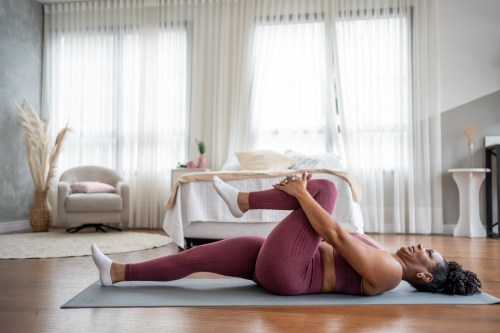Living that desk job life? Try these core exercises to alleviate low back tightness
Finish Line Physical Therapy PT Raechel Bugner shares her favorite core exercises and lower back stretches to help alleviate back pain.

Long gone are the days when back pain was something only your grandma suffered from. Today, thanks to long hours sitting at a computer followed by long nights hunched over Instagram, back pain has become particularly prominent among the spin-then-brunch generation. It’s a call for some serious lower back stretches.
“Typically back pain is the result of too much sitting, especially at desks,” says Raechel Bugner, PT, DPT, FAFS, at Finish Line Physical Therapy in New York City. “Sitting causes tightness in the hip flexors, which then pull the pelvis forward. This, in turn, causes increased extension and compression in the low back even after you stand up. That means these muscles never get an opportunity to ‘shut off’ because they’re constantly holding you in this position, which also contributes to an over-lengthening of your core muscles.”
The result? While you’re crushing your to-do list and firing off emails, you could also be tiring out your back muscles and compressing your spine, making it more difficult for your abs to engage the way they should throughout your day-to-day activities.
Plus, Bugner says, spending the day firing away over computer or on your phone causes the neck to protrude anteriorly and the shoulders to round forward, which leads to mid-back or neck pain. “This posturing causes the pecs and scapular musculature to tighten, and the upper traps often engage to compensate for neck positioning,” she says. “This can further exacerbate neck and mid-back pain.”
It’s easy to convince yourself you’ll sit with perfect posture, take phone calls standing up, and get up from your desk every 30 minutes for a quick lap around the office. But if those things just aren’t happening for you, Bugner says lower back stretches and core exercise strengthening exercises may be your best bet. “Working on strengthening your core will allow those over-lengthened core muscles that lay dormant throughout the day to do a bit more work, which will help alleviate compression on the spine and give your back muscles a break,” she says.
That said, some stretches and exercises may actually exacerbate back pain. Bugner suggests avoiding any exercises that cause you to actively engage and strengthen the low back, such as back extension exercises or Supermans. “Oftentimes, low back weakness isn’t actually the cause of your low-back pain,” Bugner says. “You’re likely activating muscles that are already over-worked and further compressing a spine that’s likely already being compressed.”
Ready to get started? Here are four core exercises and lower back stretches to give a go in your next workout.

Kneeling Hip Stretch
How to do it: Place a pillow under one knee with the opposite leg out in front to stabilize your body. Gently engage the glute muscles to tuck the pelvis underneath you, which should give you a gentle stretch. If you don’t tuck your pelvis, you won’t be stretching your hips, and will likely be driving motion through the low back, which may actually aggravate the pain. Maintaining this pelvic tuck, gently drive the hips forward and then back off slightly. Repeat 10 times, then do the same stretch while driving the hips at a slight forward-diagonal toward the supported leg. You should feel the inner thigh stretch. Repeat 10 times, then switch legs. Do this in the morning and at night.
Why to do it: “This stretch will help open up the front of the hips to allow for improved mobility of the pelvis, which should help relieve compression on the low back,” Bugner says.
Pec Stretch
How to do it: Stand in a doorway with the right elbow and shoulder at 90 degrees, and the right elbow supported on the door frame. Gently turn your body away from the arm in the door frame until you feel a stretch through the front of the chest. Be careful not to generate pain or pinching in the shoulder. If this happens, straighten the elbow and lower hand in the door frame to hip height and repeat. Come in and out of the dynamic stretch gently 10 times, and then repeat on the left side. Do this every time you get up to go to the bathroom.
Why to do it: “This stretch will open up the front of your shoulders, which often get tight when typing on a computer or phone throughout the day, and will allow for improved mobility of the mid-back,” says Bugner.
Plank Matrix
How to do it: Come into a plank position either on the hands or lowered onto the elbows. Take a deep exhale and tuck the ribs down toward the pelvis. This should take pressure out of the low back, and you should feel your core activate. While maintaining this rib position, drive the hips and shoulders back as if you’re doing downward dog, and then forward back into a plank. Repeat 10 times. Take a brief rest, then resume the plank and rib position, this time driving the hips side to side. Be careful not to let the hips rotate or tip. Repeat 10 times. Take another rest, then resume the plank and rib position and rotate and drop the hip bone toward the ground. Return to plank and then drop the opposite hip bone to the ground. Repeat 10 times.
Why to do it: “This exercise will help strengthen the entire core and mid-back musculature,” Bugner says. And a strong core is a happy core—and back.
Cat Position with Knee Lift
How to do it: Set up a cat position with the shoulders directly over the wrists, tucking the pelvis, and rounding the back. Actively tuck the ribs down toward the pelvis to further round through the spine. Lift the knees about an inch off the floor. Maintain this position for three deep exhales. Feel your core engage further with each exhale, being careful not to let the back start to straighten out or the shoulders hike up to the ears. Keep the shoulder blades pulled down and away from the ears. Repeat 10 times.
Why to do it: “This move will help strengthen the core without allowing the low-back muscles to take over,” Bugner says.
BTW: There are also some killer yoga moves that can help to combat desk-driven tightness and here’s a 15-minute toning flow you can do at your desk.
Sign Up for Our Daily Newsletter
Get all the latest in wellness, trends, food, fitness, beauty, and more delivered right to your inbox.
Got it, you've been added to our email list.










